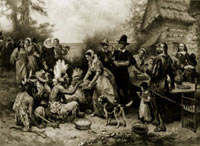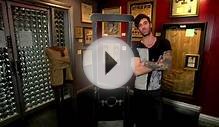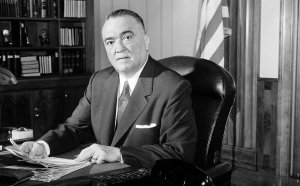
Colonial American Authors
 (The following article is taken from the U.S. Department of State publication USA Literature in Brief.)
(The following article is taken from the U.S. Department of State publication USA Literature in Brief.)
Early American and Colonial Period to 1776
By Kathryn VanSpanckeren
American literature begins with the orally transmitted myths, legends, tales, and lyrics (always songs) of Indian cultures. There was no written literature among the more than 500 different Indian languages and tribal cultures that existed in North America before the first Europeans arrived. As a result, Native American oral literature is quite diverse. Narratives from quasi-nomadic hunting cultures like the Navajo are different from stories of settled agricultural tribes such as the pueblo-dwelling Acoma; the stories of northern lakeside dwellers such as the Ojibwa often differ radically from stories of desert tribes like the Hopi.
Tribes maintained their own religions – worshipping gods, animals, plants, or sacred persons. Systems of government ranged from democracies to councils of elders to theocracies. These tribal variations enter into the oral literature as well.
Still, it is possible to make a few generalizations. Indian stories, for example, glow with reverence for nature as a spiritual as well as physical mother. Nature is alive and endowed with spiritual forces; main characters may be animals or plants, often totems associated with a tribe, group, or individual. The closest to the Indian sense of holiness in later American literature is Ralph Waldo Emerson's transcendental "Over-Soul, " which pervades all of life.
The Mexican tribes revered the divine Quetzalcoatl, a god of the Toltecs and Aztecs, and some tales of a high god or culture were told elsewhere. However, there are no long, standardized religious cycles about one supreme divinity. The closest equivalents to Old World spiritual narratives are often accounts of shamans initiations and voyages. Apart from these, there are stories about culture heroes such as the Ojibwa tribe's Manabozho or the Navajo tribe's Coyote. These tricksters are treated with varying degrees of respect. In one tale they may act like heroes, while in another they may seem selfish or foolish. Although past authorities, such as the Swiss psychologist Carl Jung, have deprecated trickster tales as expressing the inferior, amoral side of the psyche, contemporary scholars – some of them Native Americans – point out that Odysseus and Prometheus, the revered Greek heroes, are essentially tricksters as well.
Examples of almost every oral genre can be found in American Indian literature: lyrics, chants, myths, fairy tales, humorous anecdotes, incantations, riddles, proverbs, epics, and legendary histories. Accounts of migrations and ancestors abound, as do vision or healing songs and tricksters' tales. Certain creation stories are particularly popular. In one well-known creation story, told with variations among many tribes, a turtle holds up the world. In a Cheyenne version, the creator, Maheo, has four chances to fashion the world from a watery universe. He sends four water birds diving to try to bring up earth from the bottom. The snow goose, loon, and mallard soar high into the sky and sweep down in a dive, but cannot reach bottom; but the little coot, who cannot fly, succeeds in bringing up some mud in his bill. Only one creature, humble Grandmother Turtle, is the right shape to support the mud world Maheo shapes on her shell – hence the Indian name for America, "Turtle Island."
The songs or poetry, like the narratives, range from the sacred to the light and humorous: There are lullabies, war chants, love songs, and special songs for children's games, gambling, various chores, magic, or dance ceremonials. Generally the songs are repetitive. Short poem-songs given in dreams sometimes have the clear imagery and subtle mood associated with Japanese haiku or Eastern-influenced imagistic poetry. A Chippewa song runs:
A loon I thought it was
But it was
My love's
splashing oar.
Vision songs, often very short, are another distinctive form. Appearing in dreams or visions, sometimes with no warning, they may be healing, hunting, or love songs. Often they are personal, as in this Modoc song:
I
the song
I walk here.
Indian oral tradition and its relation to American literature as a whole is one of the richest and least explored topics in American studies. The Indian contribution to America is greater than is often believed. The hundreds of Indian words in everyday American English include "canoe, " "tobacco, " "potato, " "moccasin, " "moose, " "persimmon, " "raccoon, " "tomahawk, " and "totem." Contemporary Native American writing, discussed in chapter 8, also contains works of great beauty.
RELATED VIDEO



Share this Post
Related posts
Asian American Authors
April 1, 12:00 PM *This event is not held at the Workshop in NY* What do Ralph Ellison, Harper Lee, and John Steinbeck have…
Read MoreBlack American Authors
Black History Month honors and celebrates the contributions of African Americans in the rich fabric of American life and…
Read More










